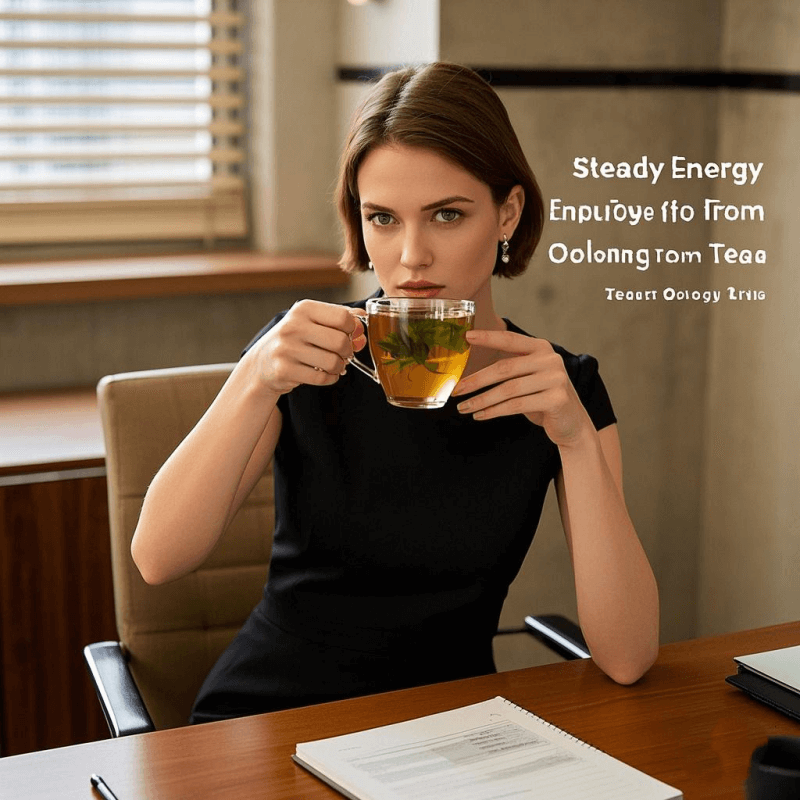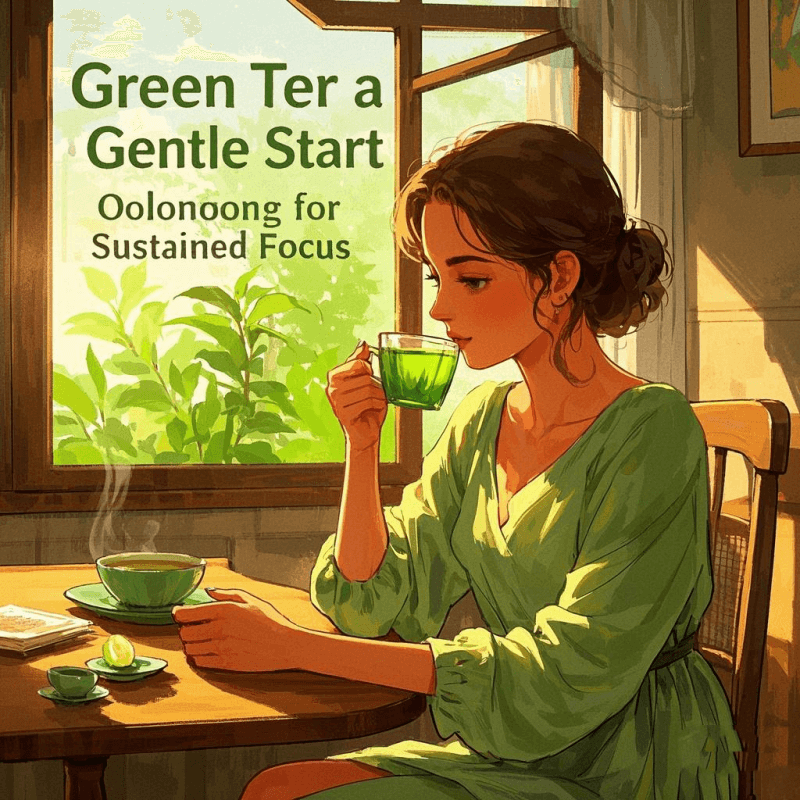
1. Introduction: Why Compare Caffeine in Oolong Tea vs Green Tea?
For many tea lovers, the right cup isn’t just about flavor—it’s about how it makes you feel. That’s why understanding caffeine in oolong tea vs green tea matters. Both teas come from the Camellia sinensis plant, but their caffeine levels and effects differ, making them suited to different moments: a morning pick-me-up, an afternoon focus boost, or a calm evening unwind.
Caffeine is a natural stimulant that enhances alertness, but too much can cause jitters or energy crashes. By comparing caffeine in oolong tea vs green tea, you’ll learn which brew aligns with your tolerance, schedule, and wellness goals. Whether you crave a gentle lift or a brighter boost, this guide will help you choose confidently. Let’s start by exploring what makes these teas unique.
2. What Is Oolong Tea? What Is Green Tea?
To understand caffeine in oolong tea vs green tea, we first need to grasp their origins and processing—two factors that shape their caffeine content and character.
🍃 What Is Oolong Tea?
This semi-oxidized tea falls between green and black varieties, with oxidation levels ranging from 10–80%. This middle ground gives it incredible versatility: lightly oxidized types (like Tie Guan Yin) offer floral, buttery notes, while heavily oxidized varieties (such as Da Hong Pao) lean rich and roasted. Grown primarily in China (Fujian, Guangdong) and Taiwan (Alishan, Dong Ding), this tea thrives in high-altitude, misty regions that slow leaf growth, concentrating both flavor and nutrients.
🌱 What Is Green Tea?
Green tea is minimally oxidized (0–10%), a process that preserves its bright, grassy flavor and high levels of catechins—powerful antioxidants. Originating in China but now grown globally (Japan’s Matcha, India’s Darjeeling green), it’s processed by steaming or pan-frying fresh leaves immediately after harvest to stop oxidation. This quick handling locks in its vibrant color, fresh aroma, and unique nutrient profile.
While both teas share the same plant parent, their processing paths create distinct caffeine profiles—a key part of caffeine in oolong tea vs green tea comparisons.
3. How Much Caffeine Is in Oolong Tea vs Green Tea?
The most critical question in caffeine in oolong tea vs green tea is: how much caffeine do they actually contain? Let’s break down the numbers, based on standard 8oz (240ml) servings.
☕ Caffeine in Oolong Tea
On average, this semi-oxidized tea contains 30–50mg of caffeine per 8oz cup. However, this range varies:
- Lightly oxidized varieties (e.g., Tie Guan Yin): 30–40mg (milder, floral types).
- Darker, more oxidized options (e.g., Da Hong Pao): 40–50mg (richer, roasted profiles).
This moderate level makes it a popular choice for those seeking a balanced lift without the intensity of coffee.
🌿 Caffeine in Green Tea
Green tea typically has 20–45mg of caffeine per 8oz cup, with variations based on type:
- Sencha (Japanese green tea): 25–35mg (bright, grassy).
- Matcha (powdered green tea): 35–45mg (more concentrated, as you consume the entire leaf).
- Dragon Well (Longjing, Chinese green tea): 20–30mg (smooth, nutty).
At first glance, the ranges overlap, but caffeine in oolong tea vs green tea often comes down to specific varieties and brewing methods—factors we’ll explore next.
4. What Affects the Caffeine Levels in These Teas?

Caffeine in oolong tea vs green tea isn’t set in stone; it’s influenced by several variables that change how much caffeine ends up in your cup. Understanding these factors helps you control your intake.
🌱 Plant Variety and Growing Conditions
- Oolong Varieties: Grown in high-altitude regions (600–1,200m), these bushes develop slower, with leaves that accumulate caffeine as a natural defense against pests. Types like Alishan oolong (Taiwan) tend toward the lower end of the caffeine spectrum due to their mountainous environment.
- Green Tea: Shade-grown green teas (e.g., Gyokuro) have slightly higher caffeine than sun-grown types, as the plant produces more caffeine to compensate for reduced sunlight.
👨🌾 Processing Methods
- Oolong Preparation: Partial oxidation (10–80%) doesn’t significantly reduce caffeine, but rolling and shaping can affect extraction. Tightly rolled leaves release caffeine more slowly during brewing.
- Green Tea: Minimal oxidation preserves caffeine, but steaming (Japanese method) vs. pan-frying (Chinese method) has little impact on final caffeine levels.
🔥 Brewing Variables
- Steep Time: Longer steeping extracts more caffeine. A 3-minute steep for oolong yields more caffeine than a 1-minute steep.
- Water Temperature: Hotter water (185–205°F for oolong, 160–180°F for green tea) accelerates caffeine release.
- Leaf-to-Water Ratio: More leaves mean more caffeine. Using 2 teaspoons of oolong per cup vs. 1 teaspoon will increase your intake.
As Healthline notes, “Brewing is the biggest wildcard in tea caffeine content—even the same tea can vary by 20–30% based on how you prepare it.” This variability is why caffeine in oolong tea vs green tea depends as much on your ritual as the tea itself.
5. Which Tea Gives a Better Energy Boost Without the Crash?
Caffeine isn’t the only factor in energy levels—other compounds in tea shape how that caffeine affects your body. This is where caffeine in oolong tea vs green tea gets interesting: their unique blends create different energy experiences.
⚡ Oolong: Steady, Sustained Energy
This semi-oxidized tea contains L-theanine, an amino acid that works with caffeine to create a “calm alertness.” L-theanine slows caffeine absorption, preventing spikes and crashes. Studies show this combo enhances focus for 2–3 hours without jitters.
One regular drinker shares: “I switch to this tea in the afternoon because it keeps me productive without making me anxious. No 3 PM slump!”
⚡ Green Tea: Bright, Brief Energy
Green tea is rich in catechins (antioxidants like EGCG) that slightly moderate caffeine’s effects, but to a lesser extent than L-theanine in oolong. Its energy boost is brighter and shorter, lasting 1–2 hours—great for morning or early afternoon sipping.
A green tea enthusiast explains: “Sencha gives me a quick pick-me-up to start my day, but I can’t drink it after 2 PM without feeling restless later.”
In caffeine in oolong tea vs green tea, oolong’s L-theanine edge makes it better for sustained energy, while green tea suits those who prefer a lighter, quicker lift.
6. Choosing the Right Tea Based on Your Lifestyle
Your daily routine, caffeine tolerance, and goals should guide whether you reach for oolong or green tea. Let’s match each tea to common lifestyles.
🕒 Morning Routine
- Choose green tea if you need a gentle wake-up. Its 20–45mg caffeine, paired with catechins, kickstarts your day without overwhelming your system—perfect with breakfast.
- Opt for oolong if you want lasting energy for a busy morning. Its 30–50mg caffeine, balanced by L-theanine, keeps you focused through meetings or chores.
💼 Workday Afternoons
- Oolong is ideal here. Its steady energy avoids the “crash” that can hit after green tea, making it great for after-lunch productivity.
- Green tea works if you prefer a lighter boost, but stick to earlier afternoons (before 3 PM) to avoid sleep disruptions.
🌙 Evening Relaxation
- Both teas can work, but choose lower-caffeine varieties:
- Light oolong (30–35mg) or green tea like Dragon Well (20–30mg) in early evenings.
- Avoid matcha or dark oolong after 6 PM if you’re sensitive to caffeine.
🏋️ Fitness Goals
- Green tea’s catechins may support fat oxidation during workouts, making it a good pre-exercise drink.
- Oolong’s sustained energy aids longer sessions, and its hydration benefits support recovery.
Discover the balanced flavor and caffeine of our oolong tea collection to find your perfect match for any time of day.
7. Conclusion: Is Oolong Tea or Green Tea Better for You?
When evaluating caffeine in oolong tea vs green tea, there’s no one-size-fits-all answer—both offer unique benefits. Green tea shines with its bright flavor, lower caffeine (in most varieties), and antioxidant-rich profile, making it ideal for morning freshness or light energy needs. Oolong tea, with its moderate caffeine, L-theanine content, and smooth, versatile flavor, excels at providing steady, jitter-free energy—perfect for afternoons or all-day sipping.
Your choice depends on your caffeine tolerance, schedule, and taste: do you prefer grassy brightness or buttery complexity? Either way, both teas offer a healthier alternative to coffee, with antioxidants and subtle energy that enhance daily life.
Explore our premium green and oolong tea leaves for a perfect brew—whether you’re chasing a quick lift or sustained focus, the right cup is waiting. After all, the best tea is the one that fits your rhythm.
Compare caffeine in oolong tea vs green tea to find your perfect match. Oolong tea offers steady energy (30–50mg), green tea a lighter lift (20–45mg). Choose based on your routine and tolerance today.
